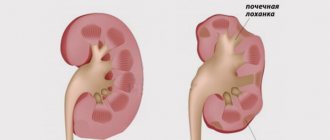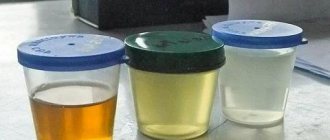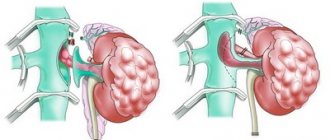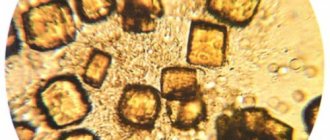Dark urine in a child may be the first sign of a developing disease of the internal organs, or its appearance is associated with exposure to medications, negative environmental factors, or certain types of food that can change the color of the color.
If a child’s yellow urine, which previously had a healthy wheat straw color, suddenly begins to become deeply darkened, the baby complains that his stomach hurts, then this is a clear symptom of pathology. Dark-colored urine, the appearance of which is not associated with disease, again acquires a yellowish tint as soon as exposure to the conditions that provoked its concentrated pigmentation ceases.
My child's urine is dark, what does this mean?
Darkening of urine in the morning, if the child feels well and does not have any accompanying symptoms, is considered normal. In the morning, urine that has accumulated in the bladder overnight always has a richer color than during the day. And this applies to both children and adults. If the urine is dark throughout the day, and this pattern is observed for several days, it is worth taking a closer look at the child.
When the baby’s behavior is without visible changes, he is no longer capricious, his body temperature has not increased, and there are no signs indicating painful sensations, with a high degree of probability it can be argued that the change in the color of urine is the ingestion of certain foods that color the urine.
Parents, however, need to be alert if their child's urine suddenly turns dark. Many diseases can occur without a pronounced symptomatic picture in the early stages, and even if nothing changes in the child’s general condition, urine will be the first to indicate the presence of pathology, changing its color and, often, smell.
Warning symptoms
Remember that darkening of urine caused by illness always entails the appearance of accompanying signs in the baby; they should alert parents and encourage them to seek help from a pediatrician. They look like this:
- urination became painful, a burning sensation inside the urethra, itching, redness of the skin surface of the genital organs;
- the child complains of discomfort in the lumbar spine closer to the edges of the back, where the kidneys are located;
- high body temperature appears, its indicators are within 38 degrees Celsius and above;
- the baby refuses to eat, complains of periodic nausea, and after eating food, vomit occurs;
- there is pronounced physical weakness, fatigue, drowsiness, decreased blood pressure (below 90 per 60 tonometer units);
- morning urine has a dark tint, putrid, unpleasant odor, which indicates a bacterial infection of the kidneys;
- the appearance of a yellow color on the skin surface of the abdomen, whites of the eyes, lower and upper extremities, discoloration of the stool, which is the first sign of dysfunction of the liver and gall bladder tissues;
- swelling of the lower extremities, the baby’s complaints about heaviness of the legs, tight shoes and pain in the left side of the chest;
- frequent and false urge to go to the toilet, due to which the child needs to urinate up to 3-4 times within 1 hour in order to feel the bladder emptying;
- urine sediment in the form of flakes, small round or cylindrical particles, detection of sand or mineral deposits resembling salt crystals.
This is a symptom that requires an immediate response from parents and a pediatrician. You can’t waste time waiting for the urine to become lighter and the baby’s poor health to return to normal. There is a high chance of developing serious disease of the kidneys, bladder, pancreas, liver, heart or great vessels.
Analysis of urine
To be sure that the change in urine color is caused by eating certain foods and not some pathology, you need to take a urine test. To diagnose diseases of the urinary system, a general urine analysis is performed.
Rules for preparing a child for analysis
No special preparation is required to take the laboratory test. The day before collecting biological fluid, you must stop giving your child sweets and a number of foods that can affect the color of urine. These are beets and carrots. If you need to take a test for a child aged 3 years or older who eats from the common table, you need to remove salty foods from the diet, for example, herring, pickled cucumbers, the day before urine collection.
When a urine test is to be performed on a breastfeeding baby, the mother must follow dietary restrictions.
Only the first daily urine is suitable for analysis, which means that urine must be collected immediately after waking up in the morning. Before collecting biological material, the child must be washed with water, without soap or gels. Urine is collected in a special container, or any washed, sterilized container. A special urine bag is used to collect urine from an infant.
Normal color of children's urine and pathological
Normally, a child’s urine should be light in color, with a straw tint. A brown tint is allowed when the concentration of pigments and salts increases, which is observed when consuming certain foods. This is especially common when a baby transitions from breastfeeding to complementary feeding. There should be no mucus, flakes or other pathological inclusions in the urine.
Pathological shades of urine are red, always dark brown. Urine should not be bright yellow.
What color of urine is normal?
Before analyzing the color shade of a child’s urine, you should learn in more detail about the norms for the optimal characteristics of the shade of urine, indicating the healthy state of the baby’s body. In the absence of pathologies from the excretory system and digestive organs, the child’s urine is yellow in color. It may change slightly in the light direction or acquire an unsaturated dark shade.
It all depends on the quality of nutrition the baby receives. In children who are breastfed with mother's milk, the urine is almost always not yellow in color, but has a pale appearance, as if there is an excess of fluid in the child's body. In fact, this is the influence of calcium salts that dissolve during digestion.
In children 3 to 4 years old, urine becomes darker in color, since their diet is already much more varied than that of infants. At 3 years old, the child already drinks tea, juices and compotes containing tannins, pigments and organic acids, from which the color of urine may temporarily become not yellow, but slightly brown.
Non-pathological factor of darkening of urine in a child
Why the color of a child’s urine becomes dark or reddish is not always the cause of this condition is a disease of the urinary tract, kidneys or organs of the reproductive system. The color of urine is influenced by the child’s diet, medication, or psychological and emotional state.
Features of baby food
The peculiarity of such a biological fluid as urine is that along with it, by-products of vital activity and food debris are removed from the body. Beets, enriched with red pigments, will certainly leave a trace in the urine, giving it an orange color, or even red if a lot of beets were eaten.
The following foods can affect the color of urine:
- beef;
- certain types of fish;
- beet;
- carrot;
- rhubarb;
- blueberry;
- blackberries (color waste by-products black).
It is enough to change your diet, excluding foods with a high content of pigments, and your urine will acquire a normal color. Dark color of urine may be due to drinking large amounts of black tea, carbonated water with nutritional supplements.
Consequences of taking medications
The color of a child's urine often changes due to taking certain medications - vitamins, some antibacterial drugs, for example Metronidazole. Antimicrobial drugs of the nitrofuran group can change the color of urine. How some drugs affect urine:
- antibiotic Rifampicin, Analgin - red urine;
- Aspirin – pink shade;
- Activated carbon – dark brown color;
- Senadexin - purple hue of urine;
- Vitamin B2 or Riboflavin – yellow urine with an orange tint.
Once the medication is stopped, the urine will return to normal color.
Hygiene for girls
Due to the peculiarities of the anatomy of the urinary system, girls are more often susceptible to infectious and inflammatory diseases of the bladder. The short length of the ureter allows pathogenic bacteria access to the organs of the urinary system. Parents need to especially carefully monitor the hygiene of the little girl’s genital organs, and if they detect signs such as changes in the color of urine, even in the absence of accompanying symptoms, immediately consult a doctor.
Pathological causes of dark urine in a child
The color of urine changes not only due to the consumption of certain foods and medications, but also due to the development of diseases of the internal organs. In addition to changes in the color of urine, with inflammatory and infectious diseases not only the color of the urine changes, but also there are accompanying symptoms.
Allergy
An allergic reaction to food manifests itself in a change in the color of the urine. The biological fluid becomes darker, and the child has signs such as a rash and redness of the skin.
Infectious diseases
The development of inflammation of the kidneys and bladder may not have pronounced symptoms in the early stages of development in the form of pain and deterioration of the general condition. But urine immediately reacts to the first changes in the condition of the internal organs. The urine darkens and acquires an unpleasant, pungent odor. As the disease progresses, mucus and light flakes may be seen in the urine.
Associated symptoms:
- lower back pain;
- in infants – moodiness, poor sleep;
- increased body temperature;
- pain when urinating;
- decreased or complete absence of appetite.
Treatment of infectious diseases must begin immediately, as they quickly lead to severe complications.
Urolithiasis disease
Urine in the presence of kidney stones is much darker and emits a very pungent, specific odor. There is a painful symptomatic picture, similar in nature to the manifestations of infectious diseases. An accurate diagnosis can only be made through laboratory analysis of urine; additional tests are prescribed - blood tests, ultrasound, and rarely - MRI.
Development of neoplasms
In the early stages of the formation of oncological tumors, there is no symptomatic picture. The only thing that can be alarming is the darkening of the urine, or the acquisition of an atypical bright color.
Poisoning
Food, drug and other types of poisoning always lead to severe intoxication of internal organs. Trying to get rid of toxic substances on its own, the body removes them with waste by-products - urine and feces, which is why urine becomes dark in color. In case of poisoning, the following symptoms are present:
- abdominal pain;
- nausea and vomiting;
- diarrhea;
- increased body temperature;
- general weakness and lethargy.
The color of urine also changes with dehydration, which always occurs with poisoning due to diarrhea and vomiting.
Other reasons
Darkening of urine can be caused by diseases of the gallbladder, jaundice due to increased concentration of bilirubin.
The color of urine is greatly influenced by the emotional state of the child. The psychology of children is structured in such a way that they have very pronounced psychosomatics and any emotional shock affects the condition and functioning of their internal organs. The influence of parental divorce, when a family breaks up, or the subsequent pregnancy of the mother, when the eldest child becomes jealous for the first time, all this can cause darkening of the urine due to stress. If the child's emotional state does not level out, a psychologist may be needed to correct the condition.
Pathological causes
In medical practice, determining the presence of a possible pathology or the influence of negative environmental factors is carried out on the basis of visual and biochemical examination of sampled urine. Based on this, the color of urine in children may indicate the development of a specific disease of the internal organs, namely:
- yellow-orange with a rich dark tint - a decrease in the filtration activity of liver tissue, possible accumulation of toxins and premature death of cells in this organ of the digestive system (in addition to this symptom, the child begins to ache in the right hypochondrium, bitterness appears in the mouth, loss of appetite, but with there are no signs indicating pathology of the kidneys or other excretory organs);
- brown urine - inflammation of the pancreas, expressed in the form of acute or chronic pancreatitis, urolithiasis, glomerulonephritis or pyelonephritis of bacterial origin, congestion in the cardiovascular system (brown urine is considered the most alarming symptom, as it may indicate the development of the most dangerous diseases internal organs of infectious etiology);
- rich dark color of urine with a greenish tint is the main sign of a painful condition of the gallbladder, twisting of its base or bending of the neck, which disrupts the natural circulation of bile in the tissues of the liver and other parts of the digestive system (in some cases, urine of this color in a child may indicate cirrhosis liver, severe hepatitis or extensive intoxication of the body).
Treatment and preventive measures
Therapy for infectious and viral diseases that are accompanied by darkening of urine is selected individually, depending on the diagnosis and the severity of the clinical case. During treatment, parents are recommended to keep a calendar that records the daily change in urine color, this will help track the degree of positive dynamics from treatment.
Prevention of diseases of the urinary system - careful hygiene of the genital organs, a proper diet enriched with vitamins and timely treatment of any infectious diseases, regardless of the location of the inflamed organ.











